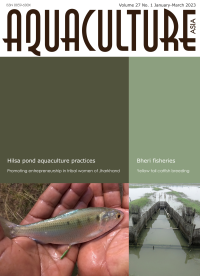Culture of hilsa, Tenualosa ilisha in freshwater ponds: Progress and prospects in farming practice
3 February 2023 | D.N. Chattopadhyay, A. Chakraborty, P.K. Roy, R.N. Mandal, A. Das, A. Hussan, S. Adhikari, B.N. Paul, B.R. Pillai and S.K. Swain | 940 Downloads | .pdf | 6.62 MB | Freshwater finfish, Hatchery and nursery, India
Hilsa are a highly favoured food fish on the Indian subcontinent, but wild populations have been declining very fast due to over exploitation and disturbance of their riverine spawning grounds. Hilsa have a complex life cycle, migrating from the sea to riverine environments to spawn and are very sensitive to handling, which has complicated efforts to breed them in captivity.
The ICAR-Central Institute of Freshwater Aquaculture has initiated a programme to domesticate hilsa to reduce dependence on wild catch. This article documents the first successful approaches to rear larvae through to table sized fish and to develop mature hilsa broodstock in a farm environment.
Creative Commons Attribution.

